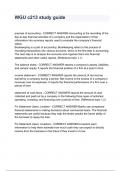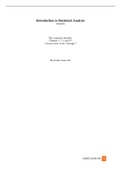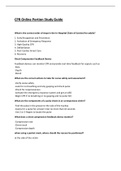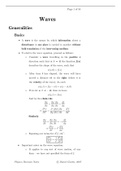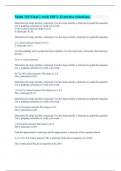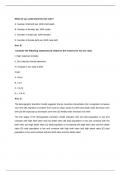Lecture 1 - Introduction to Interpersonal Relationships
Coyne et al., 2001; Heart-failure study
• Gave questionnaire about marriage quality to men after heart-failure
• Relationship quality predicted survival changes of the men four years later
• Better relationship = better survival chances
A classic: Berkman & Syme study (1979)
• Social integration has a huge impact on mortality (chances of dying within the next nine years)
• More social integration = higher changes of staying alive
Cohen et al (1997): Rhino-virus injection
• Social integration influenced whether patients got ill after being injected with a rhino-virus
• There was a higher percentage of infections in those with lower integration levels
• Conclusion
• Relationships have a direct effect on our immune system
Mortality Risk Studies
• After smoking, social relationships have the highest influence on mortality
• Which means that it has a higher influence than alcohol consumption, physical activity,
obesity and air pollution
• The influence of social support and social integration is often highly underestimated (by lay
people and professionals)
• Often perceived as one of the factors with the lowest influence even though they belong to
those with the most
Why is social integration associated with both physical and psychological well-being?
• Social Integration → Social support → Health and well-being
• Social Support
• Emotional support and Instrumental support
• Strongly correlated and often “confounded"
• Emotional Support: Caring for someone and being there for them
• Instrumental Support: Providing resources
• “Visible and “Invisible” support
• Invisible (subtle) support sometimes works better
1
, • Visible (explicit) support can elicit negative side-effects (victimization, loss of autonomy),
especially in case of relatively low distress in support recipient
Social Support → Health and Well-being: How?
• Direct effect hypothesis / Main effect Hypothesis
• Cohen & Wills (1985)
• E.g. social support makes makes people take better care of themselves (less smoking,
more exercise, healthier diet, etc); social influence/norms
• Experience more positive affect and positive emotions
• Stress-buffering hypothesis
• Social support reduces stress under potentially stressful circumstances
• Stress (e.g. cortisol) directly related to health via cardio-vascular and immune system
Lending a hand (Can et al., 2006)
• fMRI study; neurophysiological responses to anticipated pain
• 3 conditions
• Holding hand of romantic partner
• No Hand holding
• Stranger held hand
• Less stress-related brain activity when the hand is held, especially by the partner
• Especially the case when the relationships was reported to be good
Strength and strain model of marriage and health
2
,Baby Incubator Findings
• If a twin who wasn’t doing well was along with their twin in an incubator, the health improved
more than it did alone
Thus…
• Having an extensive social network strongly associated with people’s psychological and physical
well-being
• Social support is key; has a direct and indirect (stress-buffering effect)
• The Role of relationships on health and well-being is underestimated by laypeople and
psychologists
The Need to Belong
• Evolved need to initiate and maintain relationships; critical for survival
• Similar to need for food and water
Supporting the Need to Belong Hypothesis
• Changes in “belongingness” evoke strong effects
• Inclusion / Social integration = healthy and happy
• Exclusion / loneliness = unhealthy and unhappy
• Initiation of social interactions seems innate + humans form social relationships really easily
• Universal
• Minimal group research (e.g. Taijfel):
• Divide lecture hall into groups and people identify quickly with that group and show
ingroup favoritism etc.
• Mere proximity leads to relationships
• Attachment
The face perceptual system
• 30 minute old babies attend their gaze more to faces than other equally complex stimuli
• You can see faces in inanimate objects
Reactions to changes in belongingness: Social exclusion
• Ostracism Frisbee example
• Two guys played frisbee, and the frisbee landed on a researcher who joined them
• They played for about 4 minutes before the two original guys didn’t throw it to him anymore
→ Elicited bad feelings even though he didn’t even know the other guys
• Turned into studies in which the frisbee was used as well
3
,Immediate reactions to Ostracism (Need-Threat Model)
• Ostracism threatens fundamental needs
• lower sense of “belonging”
• loss of control
• lower sense of meaningfulness
• lower self-esteem (sociometer theory)
• You feel bad if you are excluded no matter what, even if you’re being excluded by a despised
group
• E.g. people in a study felt bad even when they were being excluded by KKK members
• You feel bad even if you are excluded by two animated stick people who toss each other a ball
• Activation e.g. in the anterior cingulate
“It hurts”: Pain overlap Theory
• Similar neural systems are involved in both social and physical pain
• The sensitivity to both social and physical pain is linked by a common gene (OPRM-I)
• They elicit similar psychological responses
• Both social and physical pain lead to loss of control, lowered self esteem, aggression
• Can we treat social pain with pain killers (developed for physical pain?)
• Study 1: report hurt feelings daily
• Placebo: No difference
• Paracetamol: less bad feelings
• Study 2: Brain scan during exclusion
• Placebo: No difference
• Paracetamol: Less brain activation in the “pain” areas
• Conclusion
• Using pain killers may lead to less feelings of pain when one encounters social pain
Social and physical pain dissimilarity
• Physical pain can be localized on the body, social pain can’t
• e.g my leg hurts because I knocked it against the table
• Different ways in which we manage the pain
• You can treat physical wounds with salves, bandages etc. which obviously won’t work for
social pain
• You rather manage social pain with different coping strategies
• Social pain can be relived to a much larger extend than physical pain
• E.g. we remember social hurtful memories hurts more than remembering physical hurtful
memories
4
,Is there a relationship between social exclusion and aggression?
• Do kids become aggressive if they’re excluded or are they excluded because they’re
aggressive?
• E.g. in school, do kids become aggressive when they’re being excluded by their peers or do
kids end up being excluded because they were aggressive in the first place and scared other
kids?
• There is less aggression if you gain back your sense of control
• If we’re given an opportunity for reconnection, it elicits prosocial behavior in us
What social exclusion can lead to
• In at least 12 of 15 school shootings either chronic ostracism /exclusion (bullying), or acute
exclusion play a role
• “How many people do I have to kill before someone notices me” - Oklahoma shooter
Summary: Need-threat Model of ostracism (Williams)
5
, Lecture 2 - Evolutionary perspectives on mating and relationships
Basics
• Variation
• Differences of genes/mutations within the same species (that can potentially be of
advantage or disadvantage)
• Heritability
• Passing on genes and potential mutations to the next generation. Some genes/mutations
may be more heritable than others
• Selection
• Those individuals with advantageous genes/mutations survive and can pass those down
onto their offspring. Those without the advantageous genes/mutations and those who might
even have disadvantageous genes/mutations will die and won’t have the chance to produce
offspring. Nature therefore performs a “selection” on the individuals of a population/species
• Example
• During the course of evolution of giraffes, those with long necks had an advantage
compared to those with short necks (Variation). Long-neck giraffes had an additional food
source up in the crowns of the trees, while those with short necks had to compete for the
scarce food sources on the ground. Long-neck giraffes therefore survived more easily than
short-neck giraffes, and could pass down their long-neck genes to their offspring while those
with short-necks died and couldn’t produce offspring to pass their genes down to
(Heritability). Nature therefore “kept” those individuals that fit to their environment and had
the potential to survive, thrive and reproduce in it, and sorted out those which didn’t fit over
the course of time and evolution (Selection)
In the 70s: Sociobiology
• Certain behaviors (A) (just like physical traits) have more survival- and reproduction (adaptive
fitness) value than other behaviors (B)
• Result
• Genes associates with A will — over generations —increase in population and B will die out
Two classic sociobiology examples
• Fear of potentially deadly animals → predisposed avoidance
• snakes, spiders etc.
6
Coyne et al., 2001; Heart-failure study
• Gave questionnaire about marriage quality to men after heart-failure
• Relationship quality predicted survival changes of the men four years later
• Better relationship = better survival chances
A classic: Berkman & Syme study (1979)
• Social integration has a huge impact on mortality (chances of dying within the next nine years)
• More social integration = higher changes of staying alive
Cohen et al (1997): Rhino-virus injection
• Social integration influenced whether patients got ill after being injected with a rhino-virus
• There was a higher percentage of infections in those with lower integration levels
• Conclusion
• Relationships have a direct effect on our immune system
Mortality Risk Studies
• After smoking, social relationships have the highest influence on mortality
• Which means that it has a higher influence than alcohol consumption, physical activity,
obesity and air pollution
• The influence of social support and social integration is often highly underestimated (by lay
people and professionals)
• Often perceived as one of the factors with the lowest influence even though they belong to
those with the most
Why is social integration associated with both physical and psychological well-being?
• Social Integration → Social support → Health and well-being
• Social Support
• Emotional support and Instrumental support
• Strongly correlated and often “confounded"
• Emotional Support: Caring for someone and being there for them
• Instrumental Support: Providing resources
• “Visible and “Invisible” support
• Invisible (subtle) support sometimes works better
1
, • Visible (explicit) support can elicit negative side-effects (victimization, loss of autonomy),
especially in case of relatively low distress in support recipient
Social Support → Health and Well-being: How?
• Direct effect hypothesis / Main effect Hypothesis
• Cohen & Wills (1985)
• E.g. social support makes makes people take better care of themselves (less smoking,
more exercise, healthier diet, etc); social influence/norms
• Experience more positive affect and positive emotions
• Stress-buffering hypothesis
• Social support reduces stress under potentially stressful circumstances
• Stress (e.g. cortisol) directly related to health via cardio-vascular and immune system
Lending a hand (Can et al., 2006)
• fMRI study; neurophysiological responses to anticipated pain
• 3 conditions
• Holding hand of romantic partner
• No Hand holding
• Stranger held hand
• Less stress-related brain activity when the hand is held, especially by the partner
• Especially the case when the relationships was reported to be good
Strength and strain model of marriage and health
2
,Baby Incubator Findings
• If a twin who wasn’t doing well was along with their twin in an incubator, the health improved
more than it did alone
Thus…
• Having an extensive social network strongly associated with people’s psychological and physical
well-being
• Social support is key; has a direct and indirect (stress-buffering effect)
• The Role of relationships on health and well-being is underestimated by laypeople and
psychologists
The Need to Belong
• Evolved need to initiate and maintain relationships; critical for survival
• Similar to need for food and water
Supporting the Need to Belong Hypothesis
• Changes in “belongingness” evoke strong effects
• Inclusion / Social integration = healthy and happy
• Exclusion / loneliness = unhealthy and unhappy
• Initiation of social interactions seems innate + humans form social relationships really easily
• Universal
• Minimal group research (e.g. Taijfel):
• Divide lecture hall into groups and people identify quickly with that group and show
ingroup favoritism etc.
• Mere proximity leads to relationships
• Attachment
The face perceptual system
• 30 minute old babies attend their gaze more to faces than other equally complex stimuli
• You can see faces in inanimate objects
Reactions to changes in belongingness: Social exclusion
• Ostracism Frisbee example
• Two guys played frisbee, and the frisbee landed on a researcher who joined them
• They played for about 4 minutes before the two original guys didn’t throw it to him anymore
→ Elicited bad feelings even though he didn’t even know the other guys
• Turned into studies in which the frisbee was used as well
3
,Immediate reactions to Ostracism (Need-Threat Model)
• Ostracism threatens fundamental needs
• lower sense of “belonging”
• loss of control
• lower sense of meaningfulness
• lower self-esteem (sociometer theory)
• You feel bad if you are excluded no matter what, even if you’re being excluded by a despised
group
• E.g. people in a study felt bad even when they were being excluded by KKK members
• You feel bad even if you are excluded by two animated stick people who toss each other a ball
• Activation e.g. in the anterior cingulate
“It hurts”: Pain overlap Theory
• Similar neural systems are involved in both social and physical pain
• The sensitivity to both social and physical pain is linked by a common gene (OPRM-I)
• They elicit similar psychological responses
• Both social and physical pain lead to loss of control, lowered self esteem, aggression
• Can we treat social pain with pain killers (developed for physical pain?)
• Study 1: report hurt feelings daily
• Placebo: No difference
• Paracetamol: less bad feelings
• Study 2: Brain scan during exclusion
• Placebo: No difference
• Paracetamol: Less brain activation in the “pain” areas
• Conclusion
• Using pain killers may lead to less feelings of pain when one encounters social pain
Social and physical pain dissimilarity
• Physical pain can be localized on the body, social pain can’t
• e.g my leg hurts because I knocked it against the table
• Different ways in which we manage the pain
• You can treat physical wounds with salves, bandages etc. which obviously won’t work for
social pain
• You rather manage social pain with different coping strategies
• Social pain can be relived to a much larger extend than physical pain
• E.g. we remember social hurtful memories hurts more than remembering physical hurtful
memories
4
,Is there a relationship between social exclusion and aggression?
• Do kids become aggressive if they’re excluded or are they excluded because they’re
aggressive?
• E.g. in school, do kids become aggressive when they’re being excluded by their peers or do
kids end up being excluded because they were aggressive in the first place and scared other
kids?
• There is less aggression if you gain back your sense of control
• If we’re given an opportunity for reconnection, it elicits prosocial behavior in us
What social exclusion can lead to
• In at least 12 of 15 school shootings either chronic ostracism /exclusion (bullying), or acute
exclusion play a role
• “How many people do I have to kill before someone notices me” - Oklahoma shooter
Summary: Need-threat Model of ostracism (Williams)
5
, Lecture 2 - Evolutionary perspectives on mating and relationships
Basics
• Variation
• Differences of genes/mutations within the same species (that can potentially be of
advantage or disadvantage)
• Heritability
• Passing on genes and potential mutations to the next generation. Some genes/mutations
may be more heritable than others
• Selection
• Those individuals with advantageous genes/mutations survive and can pass those down
onto their offspring. Those without the advantageous genes/mutations and those who might
even have disadvantageous genes/mutations will die and won’t have the chance to produce
offspring. Nature therefore performs a “selection” on the individuals of a population/species
• Example
• During the course of evolution of giraffes, those with long necks had an advantage
compared to those with short necks (Variation). Long-neck giraffes had an additional food
source up in the crowns of the trees, while those with short necks had to compete for the
scarce food sources on the ground. Long-neck giraffes therefore survived more easily than
short-neck giraffes, and could pass down their long-neck genes to their offspring while those
with short-necks died and couldn’t produce offspring to pass their genes down to
(Heritability). Nature therefore “kept” those individuals that fit to their environment and had
the potential to survive, thrive and reproduce in it, and sorted out those which didn’t fit over
the course of time and evolution (Selection)
In the 70s: Sociobiology
• Certain behaviors (A) (just like physical traits) have more survival- and reproduction (adaptive
fitness) value than other behaviors (B)
• Result
• Genes associates with A will — over generations —increase in population and B will die out
Two classic sociobiology examples
• Fear of potentially deadly animals → predisposed avoidance
• snakes, spiders etc.
6

